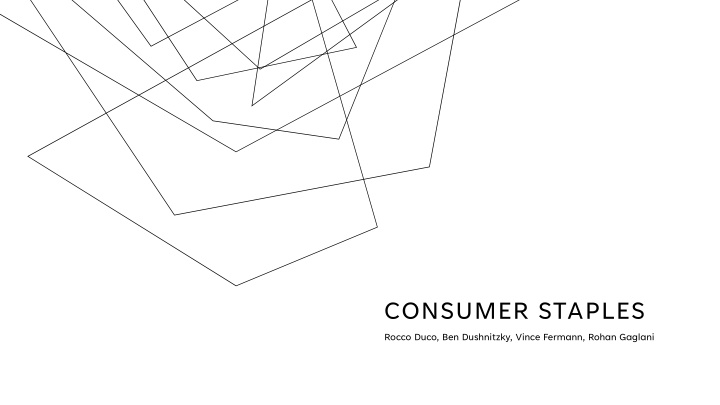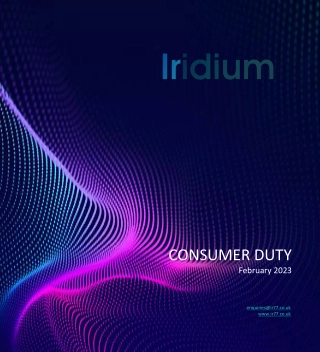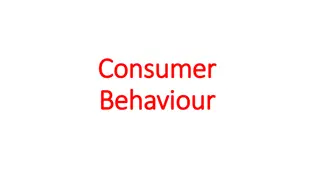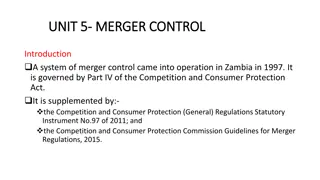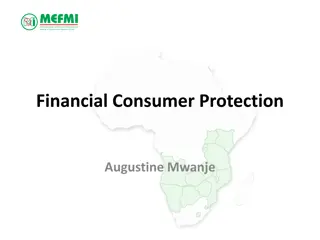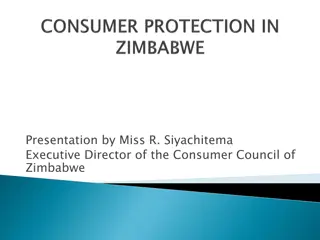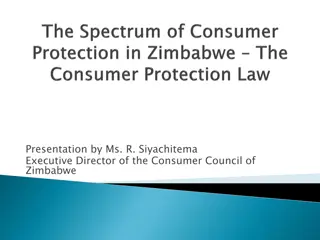CONSUMER STAPLES
The consumer staples sector, known for its defensive nature, has faced challenges in 2022 due to rising input costs and currency fluctuations. Despite hurdles, it remains resilient, driven by consistent demand for essential goods. Explore insights into sector breakdown, market constituents, and economic analysis to understand the landscape.
Uploaded on Feb 21, 2025 | 0 Views
Download Presentation

Please find below an Image/Link to download the presentation.
The content on the website is provided AS IS for your information and personal use only. It may not be sold, licensed, or shared on other websites without obtaining consent from the author.If you encounter any issues during the download, it is possible that the publisher has removed the file from their server.
You are allowed to download the files provided on this website for personal or commercial use, subject to the condition that they are used lawfully. All files are the property of their respective owners.
The content on the website is provided AS IS for your information and personal use only. It may not be sold, licensed, or shared on other websites without obtaining consent from the author.
E N D
Presentation Transcript
CONSUMER STAPLES Rocco Duco, Ben Dushnitzky, Vince Fermann, Rohan Gaglani
AGENDA Overview & Economic Analysis Business Analysis Financial Analysis Valuation Recommendation PRESENTATION TITLE 2
OVERVIEW OF THE CONSUMER STAPLES SECTOR Defensive Sector The consumer staples sector is a "defensive" sector, often outperforming the market during downturns due to the consistent demand for essential goods. Challenges in 2022 Despite its resilience, the sector faced challenges in 2022, Rising input costs and a strong US dollar, especially impacting companies with overseas sales. Some companies saw sales decline as consumers switched to cheaper alternatives.
CONSUMER STAPLES BREAKDOWN Consumer Staples Food and Staples Retail Household Products Personal Products Beverages Tobacco PRESENTATION TITLE 4
SECTOR CONSTITUENTS Market Capitalization (Reported) Total Revenue (Last Twelve Months) (Reported) Entity Name Ticker Walmart Inc. (NYSE:WMT) The Procter & Gamble Company (NYSE:PG) The Coca-Cola Company (NYSE:KO) PepsiCo, Inc. (NASDAQGS:PEP) Costco Wholesale Corporation (NASDAQGS:COST) Philip Morris International Inc. (NYSE:PM) Mondelez International, Inc. (NASDAQGS:MDLZ) Altria Group, Inc. (NYSE:MO) The Est e Lauder Companies Inc. (NYSE:EL) Colgate-Palmolive Company (NYSE:CL) Target Corporation (NYSE:TGT) Monster Beverage Corporation (NASDAQGS:MNST) The Hershey Company (NYSE:HSY) General Mills, Inc. (NYSE:GIS) Kimberly-Clark Corporation (NYSE:KMB) The Kraft Heinz Company (NASDAQGS:KHC) WMT PG KO PEP COST PM MDLZ MO EL CL TGT MNST HSY GIS KMB KHC 415,127,460.87 349,208,574.75 264,923,659.86 255,300,311.14 230,304,265.58 147,179,289.39 99,769,387.19 77,595,668.63 70,606,941.90 64,391,083.61 61,258,191.70 61,086,108.35 52,828,903.77 47,364,265.91 46,015,400.86 44,941,436.66 622,021,000 80,968,000 43,493,000 88,038,000 235,442,000 32,035,000 32,898,000 20,632,000 15,862,000 18,338,000 109,272,000 6,491,406 10,740,687 19,955,400 20,275,000 26,929,000 PRESENTATION TITLE 5
Sim Weight vs S&P500 Securities Allocation Sector S&P 500 Weight 28.05% 13.72% 12.48% 10.16% 6.90% 8.24% 4.18% 2.68% 2.41% 8.76% 2.42% SIM Weight 26.29% 16.16% 11.17% 7.95% 9.00% 7.76% 6.26% 0.92% 3.11% 11.08% 0.31% +/- -1.76% 2.44% -1.31% -2.21% 2.10% -0.48% 2.08% -1.76% 0.70% 2.32% -2.11% Information Technology Health Care Financials Consumer Discretionary Consumer Staples Industrials Energy Utilities Materials Communication Services Real Estate PRESENTATION TITLE 6
Economic Analysis: Consumer Spending Growth 7 Source: Deloitte Insights https://www2.deloitte.com/us/en/insights/economy/us-economic-forecast/united-states-outlook-analysis.html
Overview Largest in Sector: 1. Walmart Inc. (WMT) 2. The Proctor & Gamble Company (PG) 3. The Coca-Cola Company (KO) 4. PepsiCo, Inc. (PEP) 5. Costco Wholesale Corporation (COST) 6. Philip Morris International Inc. (PM) 7. Mondelez International, Inc. (MDLZ) 8. The Estee Lauder Companies Inc. (EL) 9. Altria Group, Inc. (MO) 10. Target Corporation (TGT) Consumer Staples: Usually, Non-cyclical Generally consistent dividends and earnings Dubbed as a safe haven for investors in recessionary times Companies in SIM Portfolio (as of June 2023) : Walmart Inc (WMT) Portfolio Wt. = 4.35% Kroger Co (KR) Portfolio Wt. = 3.81% Target Corp (TGT) Portfolio Wt. = 2.45% Tyson Foods (TSN) Portfolio Wt. = 0.84%
BUSINESS ANALYSIS
Phase of the Life Cycle The Consumer Staples Sector is in the Maturity phase, with consistent demand even during economic downturns. DEMAND ANALYSIS IN THE CONSUMER STAPLES SECTOR Business Cycle & Economic Influence The sector is considered "defensive", often outperforming during downturns. However, economic factors such as rising costs and a stronger US dollar in 2022 have posed challenges, and these trends are expected to continue in 2023. External Factors & Geography High oil costs and overseas sales have been challenges for the sector. Companies with exposure to emerging markets may have an advantage due to growing middle classes and consumers accustomed to inflation. Consumer Staples 11
SUPPLY ANALYSIS & PROFITABILITY IN THE CONSUMER STAPLES SECTOR Interaction of Supply and Demand Despite rising costs in 2022, companies that quickly implemented price hikes saw success. This trend is expected to continue in 2023, though consumers may be more sensitive to price increases. Companies have been profitable by demonstrating adaptability, such as adjusting package sizes and implementing cost-saving programs. Profitability Consumer Staples
PRESENTATION TITLE MARKET STRUCTURE & COMPETITION IN THE CONSUMER STAPLES SECTOR Product Segmentation & Industry Concentration The sector is diverse, including companies producing a wide range of essential goods. Industry concentration varies by product segment. Ease of Entry & Competition Substitution & Strength of Stakeholders Some companies have lost sales to cheaper alternatives, indicating substitution risks. Stakeholder strength varies, with consumers showing resilience despite price increases. The sector has high barriers to entry due to the established market presence of major companies. However, competition exists, especially from private-label brands. 13
FINANCIAL ANALYSIS
SECTOR COMPARISON TO S&P 500 S&P 500 2019 2.9% 15.2% 32.9% 19.7% 13.9% 10.4% 0.3 9.9% 4.1 2020 2.2% 10.1% 33.9% 18.1% 11.9% 7.3% 0.3 9.5% 4.9 2021 3.1% 19.9% 35.9% 20.7% 15.5% 13.1% 0.3 8.8% 3.6 2022 3.1% 16.4% 33.3% 19.6% 14.6% 10.2% 0.3 8.8% 3.6 2023 YTD 3.1% 16.6% 33.8% 19.0% 14.2% 10.2% 0.3 7.9% 3.9 Return on Assets Return on Equity Gross Profit Margin EBITDA Margin EBIT Margin Outperforms ROA & ROE Earnings from Cont Ops Margin Total Asset Turnover (x) Levered Free Cash Flow Margin Total Debt / EBITDA (x) Under performs on Margin Higher Asset Turnover Consumer Staples Lower Debt to EBITDA ratio 2019 7.0% 20.7% 29.5% 12.3% 9.9% 5.6% 1.1 5.9% 2.9 2020 7.1% 24.2% 29.7% 12.7% 10.3% 6.4% 1.1 7.7% 2.8 2021 7.4% 26.3% 28.7% 12.3% 10.2% 6.6% 1.2 5.9% 2.6 2022 7.1% 23.0% 27.4% 11.3% 9.3% 5.8% 1.2 4.8% 2.7 2023 YTD 6.8% 21.8% 26.5% 10.5% 8.5% 5.2% 1.3 4.8% 2.8 Return on Assets (%) Return on Equity (%) Gross Profit Margin EBITDA Margin EBIT Margin Earnings from Cont Ops Margin Total Asset Turnover (x) Levered Free Cash Flow Margin Total Debt / EBITDA (x) Consumer Staples 16
SECTOR COMPARISON TO S&P 500 S&P 500 2019 2020 2021 2022 2023 2024 2025 Total Revenues, 1 Year Growth 4.5% -4.3% 16.8% 12.3% 2.0% 4.7% 5.1% EBITDA Margin 19.7% 18.1% 20.7% 19.6% 20.2% 21.0% 22.3% Historically lower revenue and earnings growth EBIT Margin 13.9% 11.9% 15.5% 14.6% 15.2% 16.0% 16.5% Net Income Margin 10.3% 7.4% 13.2% 10.2% 12.2% 12.8% 13.3% Consensus higher EPS and Revenue growth than market in 2023 Diluted EPS Before Extra, 1 Year Growth 4.5% -32.3%110.3%-12.6% 0.1% Consumer Staples 11.7% 11.3% Will this spill over into 2024? 2019 2020 2021 2022 2023 2024 2025 Total Revenues, 1 Year Growth 4.2% 2.6% 10.4% 8.4% 12.3% 3.5% 3.9% What is priced into the market? EBITDA Margin 12.3% 12.7% 12.3% 11.3% 11.2% 11.6% 11.7% EBIT Margin 9.9% 10.3% 10.2% 9.3% 9.1% 9.5% 9.8% Net Income Margin 5.5% 6.3% 6.6% 5.7% 6.6% 7.0% 7.2% Diluted EPS Before Extra, 1 Year Growth -14.6% 18.1% 15.2% -5.2% 4.2% 9.4% 9.0% Consumer Staples 17
Absolute Basis High Low Median Current P/E 23.41 15.77 20.19 22.07 VALUATION ANALYSIS P/B 7.32 3.74 5.49 6.82 P/S 1.75 1.03 1.40 1.42 P/EBITDA 15.78 9.01 12.28 14.99 Sector Ratios The consumer staples sector is valued a bit higher than the median over the past 10 years. Consistent demand = stable This implies that the sector could possibly be overvalued and could trend back down to the median in the coming years. Consumer Staples 18
COMPANY TO COMPANY VALUATION Walmart Tyson Absolute Basis Absolute Basis High Low Mean Current High Low Mean Current P/E 20.15 6.28 13.25 11.83 19.35673 34.8 P/E 50.83 8.56 2.991897 P/B 4.82 1.89 4.82 P/B 2.92 0.90 1.75 0.90 0.483455 P/S 0.73 0.3 0.67 P/S 0.82 0.17 0.55 0.33 38.7404 128.87 P/EBITDA 58.65 Tyson s current valuation is lower than the median. This is not surprising supply and demand issues have resulted in the lowest stock price in years as of May 2023 P/B Ratio of 0.90 represents the historic low Currently, WMT stock is valued higher than the historic mean, being almost double of its means for the various ratios. This implies that either the stock is overpriced or, depending on how the competitors are performing, the sector to do much better than its average values WMT is at its all time high when it comes to its P/B ratio and very close to its high when looking at its P/S ratio. The P/E ratio is high compared to its mean as well. Consumer Staples 19
Ticker P/E P/S P/B TSN 11.83 0.33 0.90 Peers COMPANY TO COMPANY VALUATION PPC 11.60 0.30 1.84 CAG 21.19 1.44 1.93 GIS 18.62 2.38 5.06 SJM 22.63 1.94 2.02 Average 17.17 1.27 2.35 Pilgrim s Pride (PPC) is one of the largest chicken producers in North America, and the chicken industry has struggled with lower consumer demand and higher prices, so it makes sense that Tyson and Pilgrim are struggling the most. General Mill s (GIS) is valued substantially higher than the rest. General Mill s products are not in the meat industry, which is why they are not struggling as much as the others.
RELATIVE TO SP500 HIGH LOW MEDIAN CURRENT P/E 1.25 0.68 1.04 1.12 P/B 2.44 1.28 1.69 1.71 RELATIVE VALUATION TO MARKET P/S 1.11 0.53 0.77 0.69 P/EBITDA 1.61 0.77 1.19 1.24 The consumer staples sector is valued higher than the S&P500. It is currently performing a bit higher than average over the past decade, which implies it is one of the driving factors in the S&P500 currently performing slightly above the median. Sector is expensive right now, which is a good sign for market strength Consumer Staples 21
RECOMMENDATION Stay overweight in consumer staples as compared to S&P500. Consensus suggests sector will outperform the market over the next year. Evaluate distribution of capital within sector as certain trades could be crowded PRESENTATION TITLE 22
